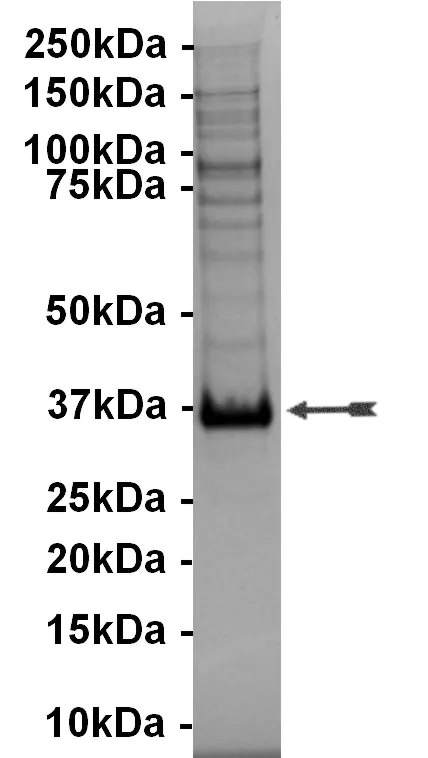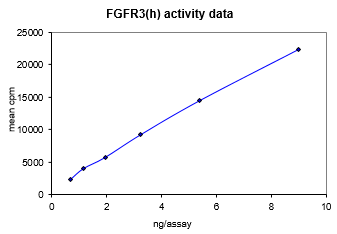FGFR3, active Human Recombinant Kinase Protein
N-terminal 6His-tagged recombinant, human FGFR amino acids 447-761.
Biological information
Background
Fibroblast growth factor (FGF) superfamily consists of 23 members, all of which contain a conserved 120 amino acid (aa) core region that contains six identical, interspersed amino acids. Based on the pI factor, two main groups of FGF are named: acidic FGF (aFGF) and basic FGF (bFGF). The superfamily members act extracellularly through four tyrosine kinase FGF receptors (FGR1 through FGR4), with multiple specificities noted for almost all FGFs. Biological binding of aFGF to its receptors will result in phosphorylation of the receptor and non-receptor proteins and generate its function. FGR3 (FGFR-3, Fibroblast growth factor receptor 3, EC 2.7.1.112) is expressed mainly in bone, central nervous system and tumors. Inhibition of FGR3 may be useful in the treatment of dwarfism as well as some tumors.
GenBank M58051
Target class
Kinase
Family
TK
Accession number
NM_000142.2; NM_022965.1
Target Name
FGFR3, active Human Recombinant Kinase Protein
Target Alias
FGFR3, HSFGFR3EX, JTK4, FGFR-3, ACH, CEK2, CD333
Origin
Human
Theori. MW
36.8 kDa
Affinity tag
6His
Product specifications
Expression system
Expressed by baculovirus in Sf21 insect cells
Purity
Refer to CoA for Purity
Purification method
Ni2+/NTA-agarose
Sample Buffer
Specified activity
Refer to CoA
Application
For Research Only
Storage conditions
1 year at -70°C
Usage disclaimer
For Research Only
Chemical data
Background
Fibroblast growth factor (FGF) superfamily consists of 23 members, all of which contain a conserved 120 amino acid (aa) core region that contains six identical, interspersed amino acids. Based on the pI factor, two main groups of FGF are named: acidic FGF (aFGF) and basic FGF (bFGF). The superfamily members act extracellularly through four tyrosine kinase FGF receptors (FGR1 through FGR4), with multiple specificities noted for almost all FGFs. Biological binding of aFGF to its receptors will result in phosphorylation of the receptor and non-receptor proteins and generate its function. FGR3 (FGFR-3, Fibroblast growth factor receptor 3, EC 2.7.1.112) is expressed mainly in bone, central nervous system and tumors. Inhibition of FGR3 may be useful in the treatment of dwarfism as well as some tumors.
GenBank M58051
Compound name
Kinase
Catalog number
14-464
Molecular formula
CAS
MW
Ka
Percent composition
Product specifications
Physical state
Purity (HPLC 214nm)
Retention time (RP18 HPLC)
CMC
Exact mass
Stability
For Research Only
Solubility structure
Kinase Activity Assay Biological information
Background
Fibroblast growth factor (FGF) superfamily consists of 23 members, all of which contain a conserved 120 amino acid (aa) core region that contains six identical, interspersed amino acids. Based on the pI factor, two main groups of FGF are named: acidic FGF (aFGF) and basic FGF (bFGF). The superfamily members act extracellularly through four tyrosine kinase FGF receptors (FGR1 through FGR4), with multiple specificities noted for almost all FGFs. Biological binding of aFGF to its receptors will result in phosphorylation of the receptor and non-receptor proteins and generate its function. FGR3 (FGFR-3, Fibroblast growth factor receptor 3, EC 2.7.1.112) is expressed mainly in bone, central nervous system and tumors. Inhibition of FGR3 may be useful in the treatment of dwarfism as well as some tumors.
GenBank M58051
Target class
Kinase
Family
TK
Subfamily
Protein Name
FGFR3
Protein Alias
FGFR3, HSFGFR3EX, JTK4, FGFR-3, ACH, CEK2, CD333
Accession Number
NM_000142.2; NM_022965.1
UniProt Number
Gene Name
Gene ID
Gene Aliases
Target Species
Human
Kinase Activity Assay Usage
Product Type
Application
Storage Conditions
1 year at -70°C
Usage disclaimer
Kinase Activity Assay Information
Assay Type
Assay Measures
Biological Information
Background
Fibroblast growth factor (FGF) superfamily consists of 23 members, all of which contain a conserved 120 amino acid (aa) core region that contains six identical, interspersed amino acids. Based on the pI factor, two main groups of FGF are named: acidic FGF (aFGF) and basic FGF (bFGF). The superfamily members act extracellularly through four tyrosine kinase FGF receptors (FGR1 through FGR4), with multiple specificities noted for almost all FGFs. Biological binding of aFGF to its receptors will result in phosphorylation of the receptor and non-receptor proteins and generate its function. FGR3 (FGFR-3, Fibroblast growth factor receptor 3, EC 2.7.1.112) is expressed mainly in bone, central nervous system and tumors. Inhibition of FGR3 may be useful in the treatment of dwarfism as well as some tumors.
GenBank M58051
Target class
Kinase
Family
TK
Accession Number
NM_000142.2; NM_022965.1
Target Name
FGFR3
Target Alias
FGFR3, HSFGFR3EX, JTK4, FGFR-3, ACH, CEK2, CD333
Origin
Human
Theoretical MW
Affinity Tag
6His
Product Specifications
Expression system
Expressed by baculovirus in Sf21 insect cells
Purity
Refer to CoA for Purity
Purification method
Ni2+/NTA-agarose
Sample Buffer
Specified activity
Refer to CoA
Application
Storage conditions
1 year at -70°C
Usage disclaimer
For Research Only
Biological Information
Background
Fibroblast growth factor (FGF) superfamily consists of 23 members, all of which contain a conserved 120 amino acid (aa) core region that contains six identical, interspersed amino acids. Based on the pI factor, two main groups of FGF are named: acidic FGF (aFGF) and basic FGF (bFGF). The superfamily members act extracellularly through four tyrosine kinase FGF receptors (FGR1 through FGR4), with multiple specificities noted for almost all FGFs. Biological binding of aFGF to its receptors will result in phosphorylation of the receptor and non-receptor proteins and generate its function. FGR3 (FGFR-3, Fibroblast growth factor receptor 3, EC 2.7.1.112) is expressed mainly in bone, central nervous system and tumors. Inhibition of FGR3 may be useful in the treatment of dwarfism as well as some tumors.
GenBank M58051
Target class
Kinase
Family
TK
Accession Number
NM_000142.2; NM_022965.1
Target Name
FGFR3
Target Alias
FGFR3, HSFGFR3EX, JTK4, FGFR-3, ACH, CEK2, CD333
Origin
Human
Theoretical MW
Affinity Tag
6His
Product Specifications
Expression system
Expressed by baculovirus in Sf21 insect cells
Purity
Refer to CoA for Purity
Purification method
Ni2+/NTA-agarose
Sample Buffer
Specified activity
Refer to CoA
Application
Storage conditions
1 year at -70°C
Usage disclaimer
For Research Only





